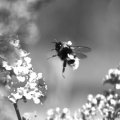A University of Queensland researcher has confirmed the existence of a gene thought responsible for greater susceptibility to candida infection in the mouth (oral thrush).
According to School of Dentistry Associate Professor Bob Ashman, the discovery has the potential to allow screening programs for greater susceptibility to candida before people's immune systems deteriorate such as in old age or during disease.
"If people are shown to be especially susceptible, they can take steps to lower their chances of contracting oral candida by adopting preventative measures and improved routine dental care," Dr Ashman said.
Candida is a common yeast infection which can break out in the mouth causing a white "fur" on the cheeks, tongue and gums. It is very painful and uncomfortable, making swallowing difficult and leaving a raw, bleeding area if dislodged.
"It can also affect the vaginal area and if it finds its way into the bloodstream can result in unexplained fevers and be potentially life-threatening," Dr Ashman said.
"Therapies involving the gene could also lower the incidence of these other forms of candida in people."
Dr Ashman said candida was particularly prevalent in the elderly, people undergoing chemotherapy, HIV/AIDS patients and babies of less than a year old.
Already funded by a three-year, $300,000 National Health and Medical Research Council (NHMRC) grant, the project recently received a further NHMRC allocation of $195,000 for 2001-2003.
Clinical trials of a new treatment method for oral thrush will begin early next year in collaboration with Professor Robert Clancy of the Royal Newcastle Hospital.
"This trial will use a new, soluble substance developed and patented by Professor Clancy on a group of elderly people prone to denture candidiasis. This occurs in many older people with false teeth," Dr Ashman said.
For more information, contact Associate Professor Bob Ashman (telephone 07 3365 3039) or Shirley Glaister at UQ Communications (telephone 07 3365 2339).



